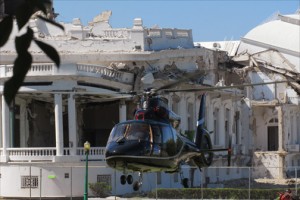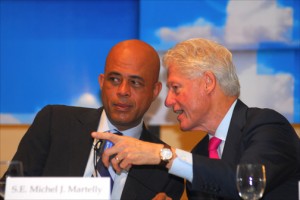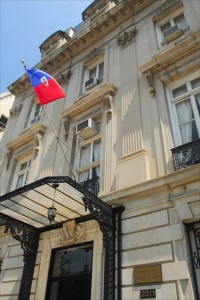Haitian ambassador seeks investment for struggling country


President Michel Martelly’s helicopter lifts off from the earthquake-ravaged presidential palace in downtown Port-au-Prince in January 2010. (Credit: Larry Luxner)
WASHINGTON — On Jan. 12, 2010 — the day a powerful earthquake destroyed Haiti’s capital city and wrecked its economy — Paul Altidor was at the Hotel Montana in Port-au-Prince, advising his government on a pending deal to privatize the state-owned phone monopoly.
At 4:53 p.m., the aspiring World Bank economist felt the ground move beneath him. When the violent shaking ended about 40 seconds later, what had long been the most luxurious hotel in Haiti — an air-conditioned oasis in the Western Hemisphere’s poorest country — was now an unrecognizable mess of concrete, a tomb trapping hundreds of locals, tourists and international aid workers. The rumbling turned to screams as people all over the city realized what had just happened.
It’s not something Altidor likes to discuss.
“Let’s put it this way,” Haiti’s new ambassador said in a recent interview in Washington. “When it comes to the earthquake, I happen to be one of the luckiest people around. I came out with only a very small scratch. But many of the folks at the Montana died. I had gone there so often on business, the employees became my closest friends.”
The Haitian government says 316,000 people lost their lives in the magnitude-7.0 quake, a far higher number than the official 230,000 figure released shortly after the disaster. Altidor says the actual death toll may never be known.
“Emotionally, the country wasn’t prepared for the magnitude of what happened that day,” said the 39-year-old envoy, who didn’t lose any immediate family in the quake.
It did change his life, however.
Instead of continuing his career with the World Bank’s International Finance Corp., Altidor became vice-president of the Clinton Bush Haiti Fund — a Washington-based nonprofit headed by former presidents Bill Clinton and George W. Bush that since the disaster has raised $54 million in donations to help Haiti get back on its feet.
Altidor’s performance on that job and his years of experience in the private sector so impressed Laurent Lamothe — Haiti’s foreign minister at the time — that Lamothe asked him to head Haiti’s embassy in Washington, D.C.
Since 2004, that mission had been run by the affable Raymond Joseph, who stepped down in August 2010 to run for president of Haiti. Then-President René Préval appointed Louis Harold Joseph (no relation) to replace him.
But the elder Joseph was soon disqualified from running because the Préval government claimed that he lacked official clearance to participate; Joseph took the case to court but the issue was never resolved. The tumultuous campaign was eventually won by Michel Martelly, a popular singer and right-of-center politician who — upon taking office in May 2011 — proudly declared that Haiti was now “open for business.”
Indeed it is, says Altidor, who presented his credentials to President Obama on May 2 amid plans to reinvent his embassy from top to bottom.
‘Emerging economy by ’30’
“As you may have heard, our goal is to make Haiti an emerging economy by 2030,” he said. “We feel that diplomacy has a key role to play in lifting Haiti from where it is right now to the next level by using the embassy to promote Haiti as an investment destination.”
Doing that, of course, takes money. Just renovating the dilapidated mission along Washington’s Embassy Row is itself a $2 million construction job, but Altidor said his budget is essentially being doubled. He’s also bringing new people aboard who can get the word out that post-earthquake Haiti wants foreign investment.
“Resources are being put at the disposal of our various diplomatic missions around the world. This is fairly new in Haiti’s recent history,” said Altidor, who plans to expand his staff of 34. “We’re hiring not just diplomats, but also folks with business backgrounds in the private sector. So I have people here with MBAs and law degrees who used to work on Wall Street. Bear in mind that in the aftermath of the earthquake, a lot of Haitians and Haitian-Americans have embraced those ideas. It’s been harder to keep people at bay than to attract talent.”
Former ambassador Raymond Joseph said Altidor recently tracked him down while in Port-au-Prince, hoping to pick up some valuable advice from an elder statesman on how to be a diplomat in Washington.
“I found him to be a humble person who listens well,” Joseph said. “He praised me for the way I dealt with the Haitian community. Whether he’s going to have a different approach, I don’t know. But at least he acknowledged there was good work done, and that he wants to continue that legacy. Apparently, he has more pull within the administration than I did, and I wish him well.”
It also helps that Altidor spent seven years in Washington and knows its think tanks, diplomatic missions and financial institutions intimately.
Born and raised in the Haitian town of Jérémie, Altidor finished high school in Boston after his family relocated there, then earned a degree from Boston College and an advanced degree from the Massachusetts Institute of Technology. At the IFC, his job was to help governments divest of state holdings by forming public-private partnerships.
“I understand Haiti and the dilemma it’s facing in terms of development, getting it right and using business diplomacy to move Haiti toward the goal of being an emerging economy by 2030,” he said. “A lot of folks come to Haiti with good intentions, but with pre-conceived solutions they think will work, as opposed to local priorities. Over the last 30 years, Haiti had become so dependent on foreign aid that it’s weakened the government, which was the very institution that was supposed to protect Haiti’s interests. So these people end up wasting resources, not because it’s malicious on their part but because they think they know better.”
All told, private U.S. and overseas donors have pledged more than $11 billion in post-earthquake assistance to Haiti through this year, though local sources say only half of that aid has actually been delivered
IADB pledges billions
The Inter-American Development Bank alone has pledged $2 billion in new grants to Haiti over a decade, reported the New York Times recently, while Congress appropriated $1.14 billion for reconstruction — much of it set aside for debt relief, health care and food and justice programs.
Yet Haiti’s government and the international donor community have come under intense criticism for a haphazard rebuilding effort that lacks any coherent, long-term vision. Altidor admits the housing challenge is a mammoth one, but also points out the tremendous strides that have been made.
“At one time, the number of people living in tents was 1.5 million. Now it’s down to less than 400,000. Some folks went back to their communities of origin, and some to new housing developments,” said the ambassador, an avid soccer fan who plays his favorite sport in the now-cleared Champs de Mars every time he returns to Haiti, which is about once every two or three weeks.
Altidor also deflected criticism that the Haitian government has squandered much of the humanitarian assistance it received in the aftermath of the January 2010 temblor.
Very little of the aid going to Haiti goes to public entities anyway, so in terms of accountability, it’s hard to even claim that the government is stealing money, when in reality it’s not being funneled to public entities but mainly NGOs. How can you be stealing something you don’t even have?”
In fact, Altidor says a big part of his job in helping run the Clinton Bush Haiti Fund “was to be certain this money wouldn’t be wasted.”
Money used wisely?
Yet the question of whether the money that’s been poured into Haiti is being used wisely continues to haunt the international community. For instance, more than a quarter of the $412 million in reconstruction funds has been earmarked for a sprawling free zone located along Haiti’s north coast — far from any quake damage.

Former President Bill Clinton shares a word with Haitian President Michel Martelly. (Credit: Larry Luxner)
“Obviously, there was no earthquake here,” senior Haitian official Michaël de Landsheer told the New York Times. “But in a sense everything in this country after the earthquake is reconstruction.”
The 608-acre Caracol Industrial Park — inaugurated late last year by Bill Clinton in a deal partially brokered by his wife, Secretary of State Hillary Clinton — will create 20,000 garment manufacturing jobs while giving companies that invest there tax exemptions, duty-free access to the U.S. market and abundant cheap labor (Haiti’s minimum wage for textile wage is set to increase next month from $3.75 to $5 a day).
Caracol’s flagship tenant will be Sae-A Trading, a South Korean apparel maker with a long history of troubled labor relations in Guatemala, where it recently closed its factory in the wake of what the AFL-CIO called Sae-A’s anti-union repression and “acts of violence and intimidation.”
Eventually, according to Martelly, the free zone, located 15 miles from the port city of Cap-Haïtien, could provide jobs for 65,000 people, boosting Haiti’s garment workforce by more than 200 percent. Sae-A is pumping $78 million into the project’s initial phase, while the U.S. government is contributing $124 million and the IDB $55 million.
Once operations at Caracol are under way, the Haitian government hopes to attract other clothing manufacturers that could benefit from U.S. trade preferences for made-in-Haiti apparel, as well as companies that make electronics and furniture. The IDB says the project will create more than $500 million in wages and benefits over the next 10 years, boosting the number of jobs in Haiti’s formal private sector by at least 20 percent.
“While Caracol constitutes a flagship project for Haiti currently in terms of investments and potential job creation, I believe Haiti will need many more of these investments if it is to come out of the poverty cycle,” Altidor said. “Caracol is a step in the right direction. However, it is one project in the government’s economic strategy.”













